Museums
1st Assistant Lightkeeper’s House
 This is the first residence you pass as you walk down the hill from the parking area to the lighthouse. It was the home of the 1st Assistant Lightkeeper. This period museum has been restored to the way the house would have looked in the 1930s. Visitors often remark on how it reminds them of the homes of their own grandparents or great-grandparents. Note the ceiling light fixture has 4 lights, reflecting the rank of the First Assistant Lightkeeper in the Light House Service. The Head Lightkeeper’s House (the middle residence) has 5 lights, while the 2nd Assistant Lightkeeper’s House (to the west) had a 3 light fixture, although that has since been replaced with a mission-style light.
This is the first residence you pass as you walk down the hill from the parking area to the lighthouse. It was the home of the 1st Assistant Lightkeeper. This period museum has been restored to the way the house would have looked in the 1930s. Visitors often remark on how it reminds them of the homes of their own grandparents or great-grandparents. Note the ceiling light fixture has 4 lights, reflecting the rank of the First Assistant Lightkeeper in the Light House Service. The Head Lightkeeper’s House (the middle residence) has 5 lights, while the 2nd Assistant Lightkeeper’s House (to the west) had a 3 light fixture, although that has since been replaced with a mission-style light.
Lighthouse Museum
 One enters the building via the lighthouse tower. Here there are examples of equipment used to illuminate and turn the lens as well as a guest book from the Lighthouse’s earliest days. The public is not permitted upstairs, except for the 8 days a year in which it is open for tours. See Upcoming Events for a schedule of these tours.
One enters the building via the lighthouse tower. Here there are examples of equipment used to illuminate and turn the lens as well as a guest book from the Lighthouse’s earliest days. The public is not permitted upstairs, except for the 8 days a year in which it is open for tours. See Upcoming Events for a schedule of these tours.
From the tower section you move into the Fog Signal Building. The main floor originally housed the air compressors that powered the fog signals. Our fog signature was 2 seconds on, 2 seconds off, 2 seconds on, and 24 seconds off. Locals learned to speak in 24 second bursts. The light has its own separate signature, blinking every ten seconds. Ships could determine their location based on the unique signatures of fog signals and lighthouses. Similarly, the white building with its unique red roof is the lighthouse daymark, which can be used to identify our particular lighthouse in the daytime.
The remainder of the Lighthouse Museum is on the main floor of the Fog Signal Building, on the right side as you enter. It shares space with the Giftshop, which is on the left.
The museum exhibits illustrate the history of Point Cabrillo, beginning with the utilization of the site by the Mitom Pomo who have harvested food from the California coast for the past 12,000 years. The wreck of the Frolic off the rocks north of the Point in 1850 triggered the immigration of settlers to the coast as redwoods and Douglas fir trees were harvested. The early history of the Light Station, its ongoing restoration, and current work are illuminated by various exhibit.
Marine Science Exhibit
 The Marine Science Exhibit is in the restored Blacksmith & Carpenter Shop, a short distance from the lighthouse. This building contains a 240 gallon seawater aquarium as well as exhibits that illuminate the local marine ecosystems and their inhabitants. Organisms in the aquarium are collected locally and retained for their lifetime. If you are lucky enough to show up at feeding time, you may see abalone gulping kelp. Feeding times are not pre-scheduled.
The Marine Science Exhibit is in the restored Blacksmith & Carpenter Shop, a short distance from the lighthouse. This building contains a 240 gallon seawater aquarium as well as exhibits that illuminate the local marine ecosystems and their inhabitants. Organisms in the aquarium are collected locally and retained for their lifetime. If you are lucky enough to show up at feeding time, you may see abalone gulping kelp. Feeding times are not pre-scheduled.
Baleen is used by some whales to filter small organisms from mud or sea water. When used in a corset, it was called whale bone. Come see some real baleen that filtered food from mud.
In the exhibit area, one side of the exhibit focuses on marine mammal ecology and behavior and the other side focuses on marine invertebrate ecology.
Kearn Farmhouse

The restored farmhouse is the building at the gate and main parking lot. Its restrooms are open, but the rest of the building is closed. The building is in the old town of Pine Grove, which once housed a brewery and a hotel.
